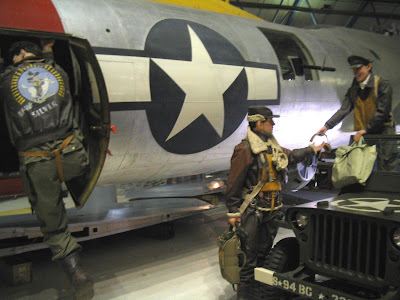 Regular readers will notice a departure from my usual range of subject matter today!
Regular readers will notice a departure from my usual range of subject matter today! I took the day off work yesterday and went by train to north London with my Boy. For a chap whose every spare moment (spare, that is, when not engaged in some rugby-related activity) is spent either making model WWII aircraft, or reading books about WWII aircraft, or playing WWII aircraft games on the Playstation, or watching The Dambusters, The Battle of Britain, 633 Squadron or The Memphis Belle . . . a trip to the RAF Museum at Hendon was long overdue.
I took the day off work yesterday and went by train to north London with my Boy. For a chap whose every spare moment (spare, that is, when not engaged in some rugby-related activity) is spent either making model WWII aircraft, or reading books about WWII aircraft, or playing WWII aircraft games on the Playstation, or watching The Dambusters, The Battle of Britain, 633 Squadron or The Memphis Belle . . . a trip to the RAF Museum at Hendon was long overdue.
My grandfather was stationed at RAF Hendon in 1933. I was taken to the museum when I was roughly my Boy’s age, and have a few rather dim memories of it. What I do remember quite vividly, however, was falling completely in love with the Lancaster Bomber. Looking back, this was a mighty strange phenomenon, since my other true loves at the time were dogs, ponies, birds and the works of Enid Blyton (this was a few years before David Cassidy came on the scene!).

Though I knew that my Boy would be in total, unquestioning Boy Heaven for the duration, I was interested to discover how the older, wiser me would react to walking amongst these relics of war, in which the young men of Britain, the US and Germany had actually sat and flown and fought and tasted terror and taken the lives of others. How would it feel to stand beneath that Lancaster once more? I doubted I'd feel that surge of romance which swept over me aged 10.

The museum has been completely revamped over the intervening years and is now huge and light and everything a modern museum should be. Above all, the word which kept springing to mind was ‘sensitive’. There was nothing there that jarred with my girlish (or motherly) sensibilities, and there was nothing that encouraged a ‘ker-pow’ attitude amongst young visitors, either. The sole emphasis of the ‘interactive’ section is on aerodynamics, the science behind aircraft design and pilot skill. Not fighting.
 In the ‘Bomber Hall’ and the Battle of Britain display, ‘enemy’ aircraft stand side by side in silent dignity, a witness to amazing feats of both engineering and human bravery. And there's a quiet (but for Elgar's Nimrod) area with a memorial to the Battle of Britain 'Few'.
In the ‘Bomber Hall’ and the Battle of Britain display, ‘enemy’ aircraft stand side by side in silent dignity, a witness to amazing feats of both engineering and human bravery. And there's a quiet (but for Elgar's Nimrod) area with a memorial to the Battle of Britain 'Few'.
 There are ample reminders of the meaning of war. This re-creation of an airfield chapel, for example, in which one can imagine those who had perhaps never previously felt any religious impulse, sitting in contemplation, fear, thanksgiving, shock, grief . . . maybe just a moment's 'peace'.
There are ample reminders of the meaning of war. This re-creation of an airfield chapel, for example, in which one can imagine those who had perhaps never previously felt any religious impulse, sitting in contemplation, fear, thanksgiving, shock, grief . . . maybe just a moment's 'peace'.

The ‘local interest’ aspect of this display struck me forcefully. On 31 August 1940, Pilot Officer Gerard Maffett took off from Martlesham Heath, Suffolk in this Hurricane, P3175, as part of a formation sent against raiding German planes. The Squadron claimed several Messerschmitts but lost two Hurricanes, one of them was P3175. Pilot Office Maffett was killed when his parachute failed to open in time as he bailed out at low altitude. The remains of his plane lay where it fell at Walton-on-the-Naze until it was recovered by volunteers from Colchester in 1973 and given to the RAF Museum in 1977. The parts have been preserved, but not repaired. ‘This provides a good insight into materials used to construct a Hurricane’, says the display board. ‘Provides a good insight into the death of a Boy as he fell from the East Anglian sky’, was the thought that haunted me when gazing at this awful twisted stump of a once-beautiful machine. Did I ‘enjoy’ seeing the big, black Lancaster again? Yes, I confess that I did. I found it deeply moving. And ‘beautiful’. It is a beautiful and absolutely awe-inspiring thing. It was my Boy’s favourite exhibit, too (and it must have been difficult for him to choose from the hundreds of other ‘favourite’ planes on display), and we found ourselves gravitating towards it again several times during our visit.
Did I ‘enjoy’ seeing the big, black Lancaster again? Yes, I confess that I did. I found it deeply moving. And ‘beautiful’. It is a beautiful and absolutely awe-inspiring thing. It was my Boy’s favourite exhibit, too (and it must have been difficult for him to choose from the hundreds of other ‘favourite’ planes on display), and we found ourselves gravitating towards it again several times during our visit.

That and its neighbouring shiny, silver US Flying Fortress. These bombers are vast – much bigger than I'd remembered. And yet the spaces in which the crew sat are absolutely tiny and cramped. Almost impossible to imagine the physical discomfort of being a rear gunner, for example (quite apart from their appalling vulnerability under fire).

And this particular Lancaster survived something like 124 missions – the second-highest number ever survived by a Lancaster. Considering the odds of its having survived even one mission, that is hugely impressive. And yes, of course, I know what those bombing raids did to Germany and to innocent Germans, and I take no pleasure in that at all, and it didn’t make me come over all frightfully British and gung-ho or anything, but it did make me feel pride in what the boys (some not that much older than mine at the time) who flew these colossal machines achieved and sacrificed.

I really would recommend this museum as a fabulous, thought-provoking place to take children (especially boys between the ages of 6 and 86).
After delays at Liverpool Street, we finally got home around 9.30 and I retired, footsore, to a long, hot, fragrant bath, with the book I'd hoped to finish on the train but barely started, and thence promptly to the Land of Nod.





















8 comments:
Food for thought Juliet and thanks for so much information, not to mention excellent pics.
My late (and favourite) uncle was a rear gunner in a Lancaster during WWII. His plane was shot down over France; the crew survived but my uncle was captured and spent two years in a German prisoner of war camp, leaving him with chronic health problems. The other members of the crew made it back to England but, on their next mission, were shot down again. This time no-one survived. Years later, my uncle and his son visited the little cemetery in France where so many of his good friends had been laid to rest. It was, as you can imagine, a very profound and moving experience for both of them.
Whatever one feels about war per se, there is no doubting the extraordinary bravery of that generation of young men.
Agreed, D. And thanks so much for sharing your personal story. I went there with ambivalent feelings and slight trepidation, fearing what I might be - 'endorsing'? 'promoting'? - by giong through the turnstile. But it is excellent - genuinely educational and mind-expanding. (As well as being Boy Heaven with icing on top.) My feet didn't arf ache by the end of the day, though, and I'd worn 'jolly sensible' boots, too!
What a lovely post, J. We took 90+ year-old mother-in-law to the museum last summer to see the Wellington bomber. Her late husband had piloted one in the war. I had been reluctant to go because I am uncomfortable around anything which appears to advocate or glorify war but, as you point out, this museum does not do that. I felt we could honour those who showed such courage and celebrate the wonders of imagination and engineering without a qualm. It is an excellent day out for all ages.
Thanks for an interesting post. I hope to be able to take my Boy there later this year.
We once introduced father-out-of-law, who'd been a POW in Europe, to a friend's father who'd flown bombers. We thought we were merely introducing two people who'd been in the war. But it turned out that the bombers had flown to Europe to collect the POWs when the war ended and these two men of 80+ had a detailed conversation about their memories of collecting and being collected - it was very moving for us to listen to.
Hi Susoz - welcome, and thanks for your comment. That must have been a fascinating (and, as you say, very moving) conversation to eavesdrop. Often these memories have remained unshared and undiscussed until very late in life.
I do hope you and your Boy enjoy the museum as much and I and mine did. You will find lots of information on the museum's website to help you plan your visit (I don't think it would be possible to see everything in a single day). Do come back and tell us how you got on!
Thank you for this, Juliet.
My late uncle was a tail gunner in a Lancaster (RCAF). It would be very moving, indeed, to see one up close.
Hi Juliet,
Gerrard Maffett is buried in Bray Cemetary near his home town of Maidenhead. I walk past it with my dog, and the kids when they can be bothered, most days. He was just 22 years old when he was killed. His mother, who lived to be 100, and who's ashes rest next to him,lost 2 sons in that war. A story repeated how many times ? This grave, along with so many others, is looked after by volunteers and is kept beautifully. I think it is important that the sacrifices that were made over and over again should be remembered now and in the future.
As a " local " you might enjoy " One Hurricane One Raid " by Geoff Rayner which tells the story of the pilot and his aircraft. There are lots of places and even names you might know. I also hugely enjoyed " First Light " by Geoffrey Wellum,
The authors account of flying through the Battle of Britain aged 18 ! No wonder his squadron called him " Boy "
Nice Blog by the way, Its the first time, ever, that I have left a commenton any site.
Best wishes
Andy
Andy - thanks so very much for taking the trouble to leave your first ever comment - this is fascinating, and moving. Bray is not far from where I grew up, and I atill pop down that way to see my parents. I shall make a point of visiting Gerard Maffett's grave next time I'm there. Thanks again. Juliet
Post a Comment